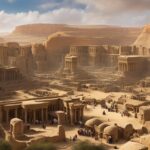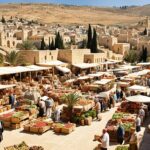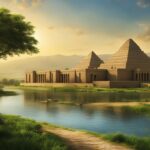Welcome to our in-depth exploration of ancient Judah, a fascinating civilization that thrived in antiquity and left an indelible mark on history. Situated in the Southern Levant, the kingdom of Judah played a vital role in the ancient Hebrew and Israelite societies, shaping the religious, social, and cultural landscape of the time.
As we delve into the historical depths of ancient Judah, we will uncover the rise and fall of this ancient Hebrew kingdom, the significant prophets who guided its people, the captivating everyday life of the Judean society, and the enduring legacy it has left on our modern world.
Key Takeaways:
- Ancient Judah was an influential kingdom in the Southern Levant, known for its rich history and cultural contributions.
- The kingdom of Judah played a crucial role in the ancient Hebrew and Israelite societies, leaving a lasting impact on religious and social practices.
- The prophets of ancient Judah, such as Isaiah, Jeremiah, and Ezekiel, shaped the religious and moral consciousness of the people, addressing issues of idolatry and justice.
- Exploring the everyday life of ancient Judah offers valuable insights into its educational systems, cultural practices, and dietary habits.
- The legacy of ancient Judah continues to resonate in the Judeo-Christian tradition and the historical narrative of the ancient Near East.
The Formation and Archaeological Record of the Kingdom of Judah
The formation of the Kingdom of Judah is a subject of debate among scholars. Some argue that Judah developed as a split from the United Kingdom of Israel, while others suggest it developed independently. The archaeological evidence for the early kingdom is still a point of contention.
Excavations in Jerusalem and Khirbet Qeiyafa support the existence of a kingdom by the 10th century BCE. The Tel Dan Stele, discovered in 1993, mentions the “House of David” ruling a kingdom in the 9th century BCE. However, the dating and identification of these findings are not universally accepted.
The archaeological record also reveals the existence of fortified cities and fortresses in Judah, such as Khirbet Qeiyafa, Lachish, and Tel Arad. Furthermore, the discovery of LMLK seals and evidence of widespread literacy suggests a well-organized society and educational infrastructure in ancient Judah.
The Prophets of the Southern Kingdom, Judah
The prophets of Judah played a significant role in shaping the religious and social landscape of the Southern Kingdom. They can be divided into two groups: those who were active before the Babylonian deportation and those who ministered during the captivity.
Before the deportation, notable prophets of Judah included Obadiah, Joel, Zephaniah, Habakkuk, Micah, Isaiah, and Jeremiah. These prophets emphasized the significance of law and justice in the life of the nation. They spoke of the impending “Day of the Lord” and the nation’s revival, calling for repentance and obedience to God’s commandments.
During the captivity, Ezekiel and Daniel emerged as significant prophets. Their prophecies provided hope and consolation to the exiled Judeans. They highlighted the restoration of the nation, the return from captivity, and the coming of the Messiah.
Prophets Before the Deportation
Here is a list of some of the prophets who ministered before the Babylonian deportation:
- Obadiah
- Joel
- Zephaniah
- Habakkuk
- Micah
- Isaiah
- Jeremiah
Each of these prophets had a unique message, but they all spoke of the importance of faithfulness to God and the consequences of disobedience.
Prophets During the Captivity
Ezekiel and Daniel were significant prophets who ministered during the captivity in Babylon. Their prophecies provided hope and consolation during a time of great despair and exile.
Ezekiel’s prophecies focused on the restoration of the nation and the renewal of the covenant between God and His people. He emphasized the importance of personal responsibility and repentance.
Daniel, known for his wisdom and visions, prophesied about future events and the coming of the Messiah. His prophecies provided hope for the exiled Judeans and assurance that God was still in control of their destinies.
| Prophet | Ministry |
|---|---|
| Ezekiel | During the captivity in Babylon |
| Daniel | During the captivity in Babylon |
The prophecies of these prophets, both before and during the captivity, have had a lasting impact on religious and cultural traditions. They continue to inspire and guide believers today, reminding them of the hope that can be found even in the midst of challenging circumstances.
Timeline: Prophets in the Reigns of Kings of Judah and Israel
The timeline of the prophets in the reigns of the kings of Judah and Israel offers a fascinating glimpse into the prophetic activity during different periods. Throughout the reigns of influential kings such as Solomon, Rehoboam, Jeroboam, Asa, Baasha, Ahab, Ahaziah, Jehu, Joash, Amaziah, Jotham, Ahaz, Hezekiah, Manasseh, Amon, Josiah, Jehoahaz, Jehoiakim, Jehoiachin, and Zedekiah, prophets were present.
| Reign of King | Prophets |
|---|---|
| Solomon | Nathan, Ahijah |
| Rehoboam | Shemaiah, Iddo |
| Jeroboam | Ahijah, unnamed prophet |
| Asa | Azariah, Hanani |
| Baasha | Jehu |
| Ahab | Elijah, Micaiah |
| Ahaziah | unnamed prophet |
| Jehu | Elisha |
| Joash | Jehoiada, Zechariah |
| Amaziah | Jehoash of Israel, unnamed prophet |
| Jotham | Isaiah |
| Ahaz | Micah |
| Hezekiah | Isaiah, Micah |
| Manasseh | Isaiah, unnamed prophet |
| Amon | unnamed prophet |
| Josiah | Zephaniah, Jeremiah, Huldah |
| Jehoahaz | unnamed prophet |
| Jehoiakim | Jeremiah, Uriah |
| Jehoiachin | Jeremiah, Ezekiel |
| Zedekiah | Jeremiah |
Each prophet had a unique ministry and message, serving as a divine voice to the people of Judah and sometimes even Israel. Their prophetic words and actions played a pivotal role in shaping the religious, social, and political landscape of their time.
Influence and Impact of the Prophets in Ancient Judah
The prophets in ancient Judah played a pivotal role in shaping the religious, social, and political dynamics of the kingdom. Through their teachings and prophecies, they challenged the prevailing idolatry and injustice in society, calling for repentance and adherence to God’s laws.
One of the notable examples of their influence was seen in the religious reforms initiated by King Josiah. Under the guidance of the prophet Jeremiah, Josiah sought to eliminate idol worship and restore the worship of Yahweh. This reform movement had a profound impact on the religious practices of the people and marked a significant turning point in the history of ancient Judah.
The prophets’ impact extended beyond religious reforms. They also played a crucial role in advocating for social reforms, emphasizing the importance of justice, mercy, and compassion. Their teachings highlighted the responsibilities of individuals and the nation to care for the vulnerable and marginalized members of society.
Moreover, the prophets’ message often centered around the hope of national revival. They spoke of a future restoration and the coming of a Messiah who would bring deliverance and establish God’s kingdom on earth. These prophetic visions inspired the people of Judah, instilling hope and a sense of purpose even in times of difficulty.
The influence of the prophets was not limited to their own time. Their writings and teachings have continued to shape the religious consciousness of ancient Judah and have been a source of inspiration for religious communities throughout history.
Today, the impact of the prophets can still be felt in the religious beliefs and practices of many. Their teachings have served as a moral compass, guiding individuals and communities towards righteousness and social justice.
Key Takeaways:
- The prophets in ancient Judah had a significant influence on the religious, social, and political dynamics of the kingdom.
- They challenged idolatry and injustice, calling for repentance and adherence to God’s laws.
- Their teachings shaped religious and social reforms, such as King Josiah’s efforts to eliminate idol worship.
- The prophets emphasized justice, mercy, and compassion, advocating for social reforms.
- They spoke of a future restoration and the hope of a Messiah, inspiring the people of Judah.
- Their writings and teachings continue to impact religious communities today.

Everyday Life in Ancient Judah
Everyday life in ancient Judah provides fascinating insights into the cultural practices and norms of this ancient civilization. Archaeological discoveries shed light on various aspects of daily life, including education, administrative systems, cultural practices, and dietary habits.
Education and Literacy
The presence of LMLK seals in ancient Judah suggests a widespread literacy among the population. These seals were used to mark storage jars and indicate the administrative organization of the kingdom. The existence of such seals implies a well-developed educational infrastructure, indicating that reading and writing were not limited to a small elite. Education in Judah likely played a crucial role in the transmission of knowledge and the administration of the kingdom.
Cultural Practices and Customs
Ancient Judah had a rich tapestry of cultural practices that defined the daily routines and rituals of its people. The discovery of vanilla traces in wine jars found in Jerusalem offers a glimpse into the refined tastes of the local elite. It suggests that vanilla-flavored wine was enjoyed during the 7th to 6th centuries BCE, reflecting the sophistication and appreciation for culinary delights.
The archaeological findings in Jerusalem reveal the cultural practices of the Judahite elite, who cherished the luxurious flavor of vanilla in their wine. This discovery showcases the refined palate and social status of the local aristocracy.
Dietary Habits and Agriculture
Dietary habits in ancient Judah were closely tied to the region’s agricultural practices. The majority of the population relied on agriculture and livestock for sustenance. Grains, such as barley and wheat, were staple crops, while olive oil and wine were also significant dietary components. Farmers cultivated these crops in the fertile lands of Judah, demonstrating the vital role of agriculture in both the economy and daily life of the people.
| Grains | Olive Oil and Wine |
|---|---|
| Barley | Olive oil from Judean olive trees |
| Wheat | Wine produced from locally grown grapes |
The cultivation of grains, along with the production of olive oil and wine, highlights the agricultural expertise and self-sufficiency of ancient Judah. These dietary practices not only provided sustenance but also shaped the cultural identity of the civilization.

In conclusion, everyday life in ancient Judah was influenced by cultural practices, educational systems, and dietary habits. The presence of LMLK seals suggests a literate society with a well-established educational infrastructure. Cultural practices, such as the enjoyment of vanilla-flavored wine, highlight the sophistication of the local elite. Agriculture played a crucial role in sustaining the population, with grains, olive oil, and wine forming the dietary staples of ancient Judah. These aspects of everyday life provide valuable insights into the social, economic, and cultural aspects of this ancient civilization.
Cities of Ancient Judah
Ancient Judah was home to several cities, both fortified and non-fortified. These cities played vital roles in the development and organization of the kingdom, serving as centers of administration, commerce, and defense. Let’s explore some of the notable cities of ancient Judah:
Khirbet Qeiyafa
Khirbet Qeiyafa is an ancient city located in the Elah Valley, southwest of Jerusalem. Excavations at this site have revealed impressive fortifications, including a massive casemate wall with two city gates. The discovery of the Khirbet Qeiyafa Ostracon, a piece of pottery inscribed with early Hebrew text, further emphasizes the city’s significance in the history of ancient Judah.
Tell en-Nasbeh
Tell en-Nasbeh, also known as Mizpah, is an archaeological site located near Jerusalem. This city served as an administrative and religious center in ancient Judah. The excavations have uncovered remains of fortifications, houses, and a large water system, shedding light on the urban planning and engineering capabilities of the time.
Khirbet ed-Dawwara
Khirbet ed-Dawwara is an ancient fortress situated in the Negev region of Judah. This strategically positioned fortress offers commanding views of the surrounding area, making it an important stronghold for defense and trade routes. Excavations have revealed evidence of a well-designed fortification system, including towers and walls.
Beth Shemesh
Beth Shemesh, located in the Shephelah region of Judah, was a significant city in ancient times. It served as a junction point for important trade routes and featured prominently in biblical narratives. Excavations have uncovered well-preserved city gates, houses, and a large storage complex, providing insights into the daily life and economic activities of the city’s inhabitants.
Lachish
Lachish, one of the largest cities in ancient Judah, was a major center for administration, trade, and military defense. Excavations at Lachish have revealed impressive fortifications, including a massive casemate wall and a well-fortified gate complex. The city is also known for its rich collection of archaeological artifacts, such as pottery, jewelry, and seals.
| City | Location | Significance |
|---|---|---|
| Khirbet Qeiyafa | Elah Valley, southwest of Jerusalem | Fortifications, early Hebrew text |
| Tell en-Nasbeh | Near Jerusalem | Administrative and religious center |
| Khirbet ed-Dawwara | Negev region | Strategic fortress, trade routes |
| Beth Shemesh | Shephelah region | Trade junction, biblical significance |
| Lachish | Southern Judah | Administrative center, impressive fortifications |
These cities of ancient Judah provide a glimpse into the urbanized and organized nature of the kingdom. The fortifications, administration centers, and trade hubs showcase the significance and vibrancy of ancient Judah’s cities.

Forts and Strongholds in Ancient Judah
The Judaean Mountains and Shephelah region in ancient Judah were home to several fortresses and strongholds. These fortified structures played a crucial strategic role in defense and maintaining control over the territory. Typically, these fortresses featured a large central courtyard surrounded by casemate walls with chambers, providing a fortified stronghold for the inhabitants.
One notable fortress in the region is Khirbet Abu et-Twein, situated between Bat Ayin and Jab’a. Perched atop a hill, this fortress offered commanding views of the Shephelah and neighboring Judahite towns, making it an ideal vantage point for surveillance and defense. Another significant stronghold in ancient Judah was Tel Arad, located in the northern Negev. This fortress served as a vital administrative and military stronghold, guarding important trade routes and ensuring control over the surrounding area.
These imposing forts and strongholds exemplify the strategic importance of defense in ancient Judah. They were not only bastions of protection but also symbols of power and control, ensuring the safety and stability of the region.

Key Features:
- Large central courtyards
- Casemate walls with chambers
- Strategic positioning
- Commanding views
- Guarding trade routes
Notable Fortresses:
| Fortress | Location |
|---|---|
| Khirbet Abu et-Twein | Between Bat Ayin and Jab’a |
| Tel Arad | Northern Negev |
The Hope for a Messiah in Ancient Judah
The people of ancient Judah held a strong Messianic hope that a deliverer, the Messiah, would come to restore their nation and establish God’s kingdom on earth. The prophets of Judah, such as Obadiah, Joel, and Zephaniah, played a pivotal role in imparting this hope to the people. They spoke of the “Day of the Lord,” a time when God would judge the nations and bring salvation and restoration to His chosen people.
These prophets prophesied about a future ruler, often referred to as the “Son of David,” who would reign in righteousness and establish peace in the land. Their words comforted the people of Judah during times of turmoil and exile, providing them with hope and assurance that God’s promises would be fulfilled.
“The Lord will be king over the whole earth. On that day there will be one Lord, and his name the only name.”
– Zechariah 14:9
The Messianic hope instilled in the people of Judah played a significant role in shaping their religious beliefs and expectations. It gave them a sense of purpose and a vision for the future, fueling their perseverance and faith in God’s deliverance.
The Day of the Lord
Central to the Messianic hope was the concept of the “Day of the Lord.” This prophetic theme conveyed the idea that God would intervene in history to bring judgment, deliverance, and restoration. It represented a future time of divine intervention when God would set things right, punishing the wicked and rewarding the righteous.
The Day of the Lord was not only seen as a day of judgment but also as a catalyst for salvation and restoration. It was a day when the Messiah would establish his kingdom, bringing peace, justice, and righteousness to the world.
“In that day the LORD will extend his hand yet a second time to recover the remnant that remains of his people, from Assyria, from Egypt, from Pathros, from Cush, from Elam, from Shinar, from Hamath, and from the coastlands of the sea.”
– Isaiah 11:11
Fulfillment and Legacy
The Messianic hope of ancient Judah found its fulfillment in the coming of Jesus Christ, who is regarded as the long-awaited Messiah in the Christian faith. Jesus’ birth, life, death, and resurrection are seen as the embodiment of the Messianic prophecies, bringing deliverance, restoration, and the establishment of God’s kingdom on earth.
The Messianic hope of ancient Judah continues to have a lasting legacy. It has shaped the religious beliefs and expectations of both Judaism and Christianity, forming the foundation for the Messianic expectations in these faith traditions.
Today, the Messianic hope serves as a reminder of the enduring faith and hope of the people of Judah. It speaks of the longing for a better future, the belief in divine intervention, and the assurance that God’s promises will be fulfilled. The Messianic hope continues to inspire and comfort believers, reinforcing the belief in the ultimate deliverance and restoration promised by God.
| Messianic Hope in Ancient Judah | Key Elements |
|---|---|
| 1 | Belief in a future Messiah |
| 2 | Expectation of deliverance and restoration |
| 3 | Prophecies of the “Day of the Lord” |
| 4 | Hope for the establishment of God’s kingdom on earth |
The Legacy of Ancient Judah in Modern Times
The legacy of ancient Judah continues to have a profound impact on the modern world. The civilization and cultural practices of ancient Judah, including its religious beliefs, social structures, and moral values, have shaped and influenced the development of the Judeo-Christian tradition. The religious texts, teachings, and prophetic writings of ancient Judah, preserved in the Hebrew Bible, serve as a foundation for both Judaism and Christianity.
“The legacy of ancient Judah is seen in the enduring influence of its prophets and their teachings.”
Prophets such as Isaiah, Jeremiah, and Ezekiel carried messages of moral responsibility, social justice, and divine intervention, which continue to resonate with believers of the Judeo-Christian faith. Their prophecies and teachings remain central to the religious and ethical framework of millions of people worldwide.
“The impact of the prophets extends beyond religious beliefs and extends to the social and political realms.”
Furthermore, the historical significance of ancient Judah reaches beyond religious traditions and has played a significant role in shaping world history. The rise and fall of the kingdom, the influence of its prophets, and the events surrounding the captivity and exile of the Judeans are essential components of the historical narrative of the ancient Near East.
“The impact of ancient Judah on world history can be seen in the political and cultural shifts that occurred in the region.”
| Key Contributions of Ancient Judah to World History |
|---|
| The preservation and spread of monotheistic beliefs |
| Influence on the development of moral and ethical principles |
| The cultural exchange and interaction with neighboring civilizations |
| The inspiration and influence on subsequent empires and civilizations |
The legacy of ancient Judah, encompassing its religious and cultural heritage as well as its impact on world history, remains a topic of ongoing exploration and study. As scholars delve deeper into the ancient texts, archaeological findings, and historical records, a greater understanding of the lasting impact and relevance of ancient Judah continues to emerge.

The Ongoing Exploration of Ancient Judah
The exploration of ancient Judah continues to be a vibrant field of research. Archaeologists, historians, and scholars are constantly making new discoveries and advancements in understanding the history and culture of the kingdom.
Advancements in technology, such as remote sensing and DNA analysis, have revolutionized archaeological research in ancient Judah. These technological advancements have allowed researchers to uncover new insights and gain a deeper understanding of the ancient civilization.
Archaeological excavations in ancient Judah have revealed remarkable artifacts, structures, and remains that shed light on the daily life, beliefs, and practices of the people who lived there. These discoveries have challenged previous assumptions and expanded our knowledge of ancient Judah.
“The exploration of ancient Judah deepens our understanding of ancient civilizations and provides invaluable insights into the historical and cultural context of the region.” – Dr. Sarah Miller, Archaeologist
The preservation of ancient sites in Judah is of utmost importance for the continuation of archaeological research. Efforts are being made to protect and conserve these sites for future generations. The conservation of ancient structures, artifacts, and inscriptions ensures that their historical and cultural significance is not lost.
New Discoveries in Ancient Judah
The ongoing exploration of ancient Judah has resulted in several exciting new discoveries. Recent archaeological findings have uncovered:
- An ancient Hebrew inscription dating back to the 7th century BCE, providing insights into the religious and cultural practices of the time.
- Remains of a fortified city in the Judean highlands, giving us a glimpse into ancient urbanization and defense strategies.
- Evidence of trade connections with neighboring regions, suggesting the economic prosperity and cosmopolitan nature of ancient Judah.
These discoveries contribute to our understanding of the kingdom’s history and help piece together the intricate puzzle of ancient Judah.
The Future of Exploration
The exploration of ancient Judah shows no signs of slowing down. Archaeologists and researchers continue to unravel the mysteries of this ancient civilization through innovative research methods and technological advancements.
As new technologies emerge and existing techniques are refined, we can expect even more groundbreaking discoveries in the years to come. These discoveries will further enrich our knowledge of ancient Judah and deepen our understanding of the past.
“The ongoing exploration of ancient Judah holds the key to unlocking the secrets of this fascinating civilization and shaping our understanding of the ancient world.” – Dr. David Cohen, Historian
Conclusion
Ancient Judah is not only a captivating chapter in the ancient Near East, but it also holds immense significance in our understanding of religious and cultural traditions. By exploring the kingdom of Judah, its prophets, cities, forts, and everyday life, we gain valuable insights into the social, political, and religious dynamics of that time. This biblical-era kingdom, with its rich history and legacy, continues to shape the beliefs and practices of millions of people today.
One of the key takeaways from the study of ancient Judah is the enduring influence it has had on our modern world. The kingdom’s impact extends beyond its historical boundaries, serving as a foundation for the development of the Judeo-Christian tradition. Its prophets, such as Isaiah, Jeremiah, and Daniel, spoke of hope, justice, and restoration, leaving an indelible mark on religious thought. The rise and fall of ancient Judah, the events surrounding the exile, and the eventual return have all played a significant role in shaping the historical narrative of the ancient Near East.
Exploring the history and culture of ancient Judah allows us to better understand our roots and the lasting impact of this biblical-era kingdom. It provides us with a deeper appreciation for the complexities of ancient societies and their role in shaping our present-day world. From the organized urban centers and fortified cities to the widespread literacy and educational infrastructure, ancient Judah offers a fascinating window into the past, reminding us of the enduring human quest for meaning, justice, and spiritual connection.







